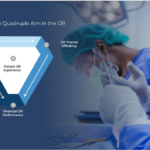Robot Assisted Surgery
Robot-assisted surgery is revolutionizing operating rooms across the world with improved surgeon precision and patient outcomes (1) for complex surgeries like total joint replacement surgery. In response, major medtech companies have developed robotic solutions to meet the demand. Despite the rapid uptake (2), some operating rooms remain apprehensive to introduce the devices due to concerns about decreased efficiency. Newly developed methods for data analysis and virtual simulations offer a way to plan and manage change thoughtfully with minimal disruptions to operational excellence in the operating room (OR).
Is your OR ready for robotic devices?
While robotic devices can add to the overall quality of any surgery, they also create additional steps to the workflow within the OR. As a result, the overall time in the OR can increase, thus reducing throughput. For healthcare providers considering making a financial investment in robotic surgery technology, the initial investment paired with the potential impact on their overall financial performance poses a significant hurdle to making the transition. And while the industry has focused on training surgeons to perform surgery with robotic devices, there has been less focus on providing support to ensure implementation without disruption to the rest of the team.
A proper introduction to the entire team is critical to the successful incorporation of robotic devices in the OR. Your team will see minimal, short-term disruptions to OR throughput and workflow – and, instead, quickly see long-term benefits.
How data-driven simulations can streamline robotic integration
Virtual simulation technology can guide healthcare providers through the process of introducing robotic devices with minimal disruption to the OR workflow. No two ORs or surgical teams are the same, and a successful change management plan takes into account all of the factors that make each OR unique. Also, the entire surgical team and facility must be aligned on best practices.
Guided by our granular approach to data analysis, DEO.care generates a digital twin of each OR and uses our proprietary simulation platform to map the most effective change process for that specific OR. Through this in-depth data analysis, we work side-by-side with hospitals and surgeons to create a plan customized for their optimum success. This approach empowers facilities to introduce this new technology in a way that makes sense for their team while maintaining healthy financial performance.
Benefits
Understand your baseline
With a remote camera application or DEO.care engineer on site, we collect 50 – 80 data points per surgery. With 8 – 10 surgeries, we have sufficient data to configure the digital twin of your OR for a specific procedure. A digital twin allows ORs to understand their current level of operational excellence, which is otherwise hard to determine. The ability to know your baseline – for example, understanding the consistency of your current processes – informs the change management process.
Map effective change
A digital twin simulation helps us see how the OR process will change and what the impact will be for the surgical team when a robotic device is introduced. Using your baseline, we then recommend the most seamless way to integrate robotic devices in your OR, taking into account your staff allocation, preferred material usage, and desired OR throughput.
Leverage best practices
DEO.care has an extensive digital twin database, embedded into our simulation platform, which includes other operating rooms’ best practices for introducing and integrating robotic devices. These best practices help us perform simulations based on your unique situation to develop change roadmaps.
Prepare your team for change
We work closely with OR teams to set up and align new processes optimally. DEO.care does this via workshops – an intentional, collaborative way to prepare staff for change. We develop standard operating procedures – embedding best practices early on – to train your surgical staff so that everyone clearly understands their new tasks and responsibilities in the new OR workflow.
How DEO.care can work with you
DEO.care helps healthcare providers understand the impact of introducing the robotic device into their OR, conduct change adoption using their unique data and other best practices, support their staff’s well-being with a clear adoption strategy and standardized workflows, and minimize the impact on their financial performance.
Do you want to know how we can help you get started? Schedule a 15-minute intro call. No strings attached.
PS. If you enjoy this content, you will definitely love the stuff we share on LinkedIn. Make sure you stay in the loop and follow our LinkedIn page.
(1) https://www.medicaldevice-network.com/comment/orthopaedic-surgical-robots-reconstruction/
(2) https://jamanetwork.com/journals/jamanetworkopen/fullarticle/2758472






